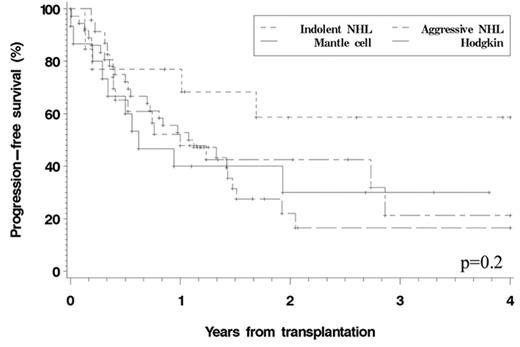The role of non-myeloablative allogeneic stem cell transplantation (NST) in the treatment of patients with Hodgkin’s disease (HD) or non-Hodgkin’s lymphoma (NHL) is still undefined. We report the outcomes of 87 patients with lymphoma who underwent NST at our institution. Thirty-six patients had HD and 51 had NHL (13 indolent NHL (indNHL), 23 aggressive NHL (aggNHL), and 15 mantle cell lymphoma (MCL)). Median age was 46 (18–64). Patients had received a median of 4 prior lines of therapy; 94% of the HD patients had received a previous autograft, as had 49% of NHL patients. 28% of patients were transplanted in CR, 49% in PR, and 23% with stable or progressive disease. The conditioning regimen consisted of IV busulfan (0.8 mg/kg/d × 4) and fludarabine (30 mg/m2/d × 4). Donors were matched related (38%), matched unrelated (56%), or mismatched (6%). Most patients received GVHD prophylaxis with a calcineurin inhibitor plus sirolimus or methotrexate. All patients engrafted. The 3-year cumulative incidence of non-relapse mortality (NRM) was 23%, and of relapse was 50%. The cumulative incidence of grade 2–4 acute GVHD was 16%, and the 2-year incidence of chronic GVHD was 68%. With a median follow-up of 21 months for survivors, the projected 3-year overall survival (OS) was 59% for patients with HD, 79% for indNHL, 42% for aggNHL, and 36% for MCL. The corresponding figures for 3-year progression-free survival (PFS) were 17% for HD, 59% for indNHL, 21% for aggNHL, and 30% for MCL.
Multivariate analysis identified elevated pre-transplantation LDH and more than 4 prior lines of therapy as adverse factors for PFS, while indolent NHL histology was a favorable factor. In time-dependent multivariable models, grade 3–4 acute GVHD was associated with increased NRM and relapse, and decreased PFS and OS. Chronic GVHD was associated with a lower risk of relapse and improved PFS, without a significant effect on OS. The protective effect of chronic GVHD on relapse applied to all histologies except for aggNHL. Forty-five percent of relapsed patients (13 pts with HD and 5 with aggNHL) received donor lymphocyte infusion (DLI). The overall response rate (ORR) was 15% (2/13) for patients with HD, with both patients remaining progression-free at last follow-up; ORR was 40% (2/5) for patients with aggNHL, but responses were transient. For all patients, median chimerism at day 20–50 was 97% (range 46–100). Low early donor chimerism was not predictive of relapse, PFS, or OS in univariate or multivariate analyses. Moreover, relapse was not associated with loss of chimerism. Finally, chimerism at the time of DLI had no apparent bearing on its outcome.
Conclusions: NST results in high PFS for indolent NHL. There is evidence of a graft-versus-lymphoma effect. Chimerism is not at any point predictive of relapse or of outcome. Future research could be aimed at increasing specific anti-lymphoma immune activity to harness GVL without increasing the incidence of GVHD.
Disclosure:Off Label Use: Use of busulfan and fludarabine for allogeneic stem cell transplantation conditioning.


This feature is available to Subscribers Only
Sign In or Create an Account Close Modal